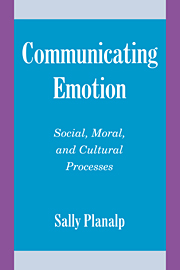Book contents
- Frontmatter
- Dedication
- Contents
- Acknowledgments
- Introduction
- 1 How Important Is Emotion in Everyday Interaction?
- 2 How and Why Is Emotion Communicated?
- 3 Is Emotional Communication Spontaneous or Strategic?
- 4 How Is Emotional Meaning Constructed Through Communication?
- 5 How Is Emotional Meaning Both Personal and Social?
- 6 How Do Emotion Messages Communicate Moral Meaning?
- 7 How Is Emotional Communication Grounded in Common Human Experience and Diverse Cultures?
- Epilogue: What is the Future of Emotional Meaning?
- References
- Author Index
- Subject Index
3 - Is Emotional Communication Spontaneous or Strategic?
Published online by Cambridge University Press: 05 February 2015
- Frontmatter
- Dedication
- Contents
- Acknowledgments
- Introduction
- 1 How Important Is Emotion in Everyday Interaction?
- 2 How and Why Is Emotion Communicated?
- 3 Is Emotional Communication Spontaneous or Strategic?
- 4 How Is Emotional Meaning Constructed Through Communication?
- 5 How Is Emotional Meaning Both Personal and Social?
- 6 How Do Emotion Messages Communicate Moral Meaning?
- 7 How Is Emotional Communication Grounded in Common Human Experience and Diverse Cultures?
- Epilogue: What is the Future of Emotional Meaning?
- References
- Author Index
- Subject Index
Summary
You learn to put your emotional luggage where it will do some good, instead of using it to shit on other people, or blow up aero-planes.
Margaret Drabble (1991)In The Expression of the Emotions in Man and Animals, published in 1872, Darwin opened a dialogue among scholars about the dual nature of emotional expression and communication that continues to this day. Darwin wrote about the expression of emotion, which captures the sense of emotion “pressing out” through the face, voice, and body. Expression is an integral part of emotion itself and happens whether we like it or not, whether we are alone or with others. It reveals our genuine or real feelings and gives others a transparent window into our hearts. Expression is founded in our genes and is directly available to others of the same species.
It took over a century for another scholar to write a book called The Communication of Emotion. Buck (1984) argued that not only do we express emotion spontaneously, but we also communicate emotion to others symbolically and strategically. Communication, as opposed to expression, is separable from the feelings themselves, happens if we intend it to happen, and is sensitive to audiences and situations. Communication can reveal either genuine or false feelings and can be a clear or distorted window into other people's hearts. Communication is founded in individual intention and in society, and communicating emotion is goal-oriented and strategic.
In this chapter, we look at emotion messages both as expression and as communication, blurring the distinction and exploring the vast gray area between them. In earlier chapters, we used the metaphor of weaving a fabric for the process of communicating emotion. Social life was the fabric, communication was the act of weaving, and emotions were the colors that enlivened it and created meaning.
- Type
- Chapter
- Information
- Communicating EmotionSocial, Moral, and Cultural Processes, pp. 71 - 103Publisher: Cambridge University PressPrint publication year: 1999

